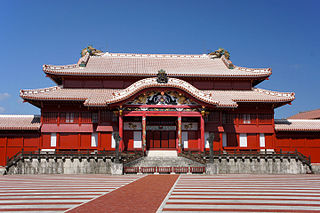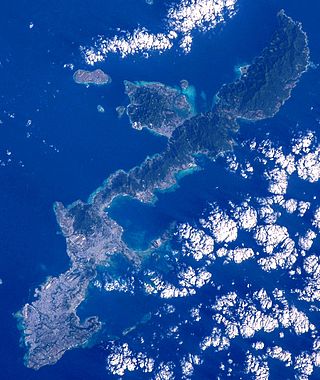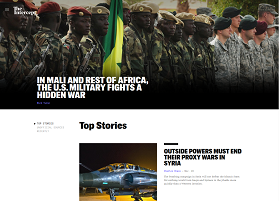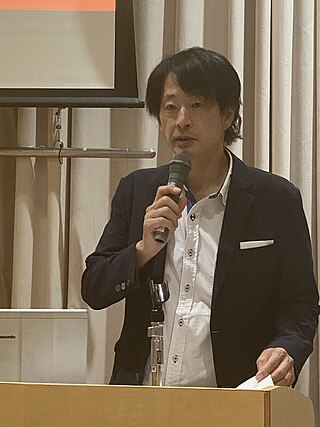
Agent Orange is a chemical herbicide and defoliant, one of the tactical use Rainbow Herbicides.

Okinawa Prefecture is a prefecture of Japan. Okinawa Prefecture is the southernmost and westernmost prefecture of Japan and has a population of 1,457,162 and a geographic area of 2,281 km2.

The United States Forces Japan (USFJ) is a subordinate unified command of the United States Indo-Pacific Command. It was activated at Fuchū Air Station in Tokyo, Japan, on 1 July 1957 to replace the Far East Command. USFJ is headquartered at Yokota Air Base in Tokyo and is commanded by the Commander, US Forces Japan who is also commander of the Fifth Air Force.

This article is about the history of the Ryukyu Islands southwest of the main islands of Japan.

Okinawa Island, officially Okinawa Main Island, is the largest of the Okinawa Islands and the Ryukyu (Nansei) Islands of Japan in the Kyushu region. It is the smallest and least populated of the five main islands of Japan. The island is approximately 106 kilometres (66 mi) long, an average 11 kilometres (7 mi) wide, and has an area of 1,206.98 square kilometers (466.02 sq mi). It is roughly 640 kilometres south of the main island of Kyushu and the rest of Japan. It is 500 km northeast of Taiwan. The total population of Okinawa Island is 1,384,762. The Greater Naha area has roughly 800,000 residents, while the city itself has about 320,000 people. Naha is the seat of Okinawa Prefecture on the southwestern part of Okinawa Island. Okinawa has a humid subtropical climate.

Marine Corps Air Station Futenma or MCAS Futenma is a United States Marine Corps base located in Ginowan, Okinawa, Japan, 5 NM northeast of Naha, on the island of Okinawa. It is home to approximately 3,000 Marines of the 1st Marine Aircraft Wing and other units, and has been a U.S. military airbase since the defeat of the Japanese Imperial Army in the Battle of Okinawa in 1945. Marine Corps pilots and aircrew are assigned to the base for training and providing air support to other land and sea-based Marines in Okinawa and throughout the Asia-Pacific region. MCAS Futenma is part of the Marine Corps Installations Pacific command.

Camp Schwab is a United States Marine Corps camp located in northeastern Okinawa Prefecture, Japan, that is currently home to the 4th Marine Regiment and other elements of the 28,000 American servicemen based on the island. The Camp was dedicated in 1959 in honor of Medal of Honor recipient Albert E. Schwab who was killed in action during the Battle of Okinawa.

Toyohiro Akiyama is a retired Japanese TV journalist and professor at Kyoto University of Art and Design. In December 1990, he spent seven days aboard the Mir space station. He became the first person of Japanese nationality to fly in space, and his space mission was the second spaceflight to be commercially sponsored and funded. Akiyama was also the first civilian to use commercial space flight, and the first journalist to report from outer space.

Camp Foster, formerly known as Camp Zukeran, is a United States Marine Corps camp located in Ginowan City with portions overlapping into Okinawa City, Chatan town and Kitanakagusuku village in the Japanese prefecture of Okinawa Island. It is part of the Marine Corps Base Camp Smedley D. Butler complex.

Camp Kinser is a United States Marine Corps logistics base in Okinawa, Japan.
Operation Red Hat was a United States Department of Defense movement of chemical warfare munitions from Okinawa, Japan to Johnston Atoll in the North Pacific Ocean, which occurred in 1971.

Beginning in the mid-1930s, Japan conducted numerous attempts to acquire and develop weapons of mass destruction. The 1943 Battle of Changde saw Japanese use of both bioweapons and chemical weapons, and the Japanese conducted a serious, though futile, nuclear weapon program.

Camp Gonsalves is a U.S. Marine Corps jungle warfare training area located in northern Okinawa, Japan, across the villages of Kunigami and Higashi. Established in 1958, it is the largest U.S. training facility in Okinawa. The camp is located in the Yanbaru forest protected area, raising long time ecological concerns enhanced by the 2016 plan to build new helipads.

Study of the environmental impact of war focuses on the modernization of warfare and its increasing effects on the environment. Scorched earth methods have been used for much of recorded history. However, the methods of modern warfare cause far greater devastation on the environment. The progression of warfare from chemical weapons to nuclear weapons has increasingly created stress on ecosystems and the environment. Specific examples of the environmental impact of war include World War I, World War II, the Vietnam War, the Rwandan Civil War, the Kosovo War and the Gulf War.
Operation Pacer IVY was a 1972 operation of the U.S. Air Force that removed Agent Orange from South Vietnam and stored it on Johnston Atoll. IVY was presumably selected as an abbreviation of InVentorY. Operation Pacer HO refers to an associated program of the United States Department of Defense (DoD), dealing with the disposition of Agent Orange from Vietnam.

The 267th Chemical Company was a military unit of the U.S. Army Chemical Corps responsible for the surety of chemical warfare agents dubbed "RED HAT" deployed to the Islands of Okinawa, Japan and subsequently Johnston Atoll in the Pacific Ocean. A recently discovered Army document reveals that the true mission of the 267th Chemical Company was the operation of the Okinawa deployment site as part Project 112. Project 112 was a 1960s biological warfare field test program that was conducted by the Deseret Test Center. Okinawa is not listed as a test site under Project 112 by the U.S. Department of Defense.

The Intercept is an online American nonprofit news organization that publishes articles and podcasts.

MaoIshikawa is an Okinawan photographer and activist. Her photographs largely feature bar girls, performers, soldiers, and other fringe members within Okinawan and Japanese society. Ishikawa's earlier works are characterized by her approach to photography which involved the photographer's immersion in the environment of her images, whether by living with her subject or working in close proximity to them. In her photographs of active soldiers and military bases both in and outside of Japan beginning from the 1990s, Ishikawa has more directly addressed political undercurrents, namely contempt for the U.S. military presence in Okinawa and distrust of the Japanese government. Her most recent series Great Ryukyu Photo Scroll (大琉球写真絵巻) (2014-) approaches the same themes through a narrative tone, using satire and pop culture references to reconstruct important moments in Okinawan history.

Eito Suzuki is a pseudonymous Japanese investigative journalist who covers new religious movements in the country. His primary area of editorial coverage is fraudulent missionary activities and the relationship between religious organizations and major political parties, primarily the Unification Church (UC) and the Liberal Democratic Party (LDP).
















